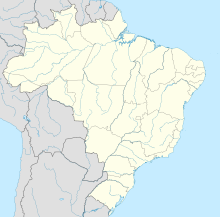Corumbá International Airport
|
Corumbá International Airport Aeroporto Internacional de Corumbá |
|||||||||||
|---|---|---|---|---|---|---|---|---|---|---|---|

Front entry of the airport
|
|||||||||||
| Summary | |||||||||||
| Airport type | Public | ||||||||||
| Operator | Infraero | ||||||||||
| Serves | Corumbá | ||||||||||
| Elevation AMSL | 141 m / 461 ft | ||||||||||
| Coordinates | 19°00′43″S 057°40′17″W / 19.01194°S 57.67139°WCoordinates: 19°00′43″S 057°40′17″W / 19.01194°S 57.67139°W | ||||||||||
| Website | Infraero CMG | ||||||||||
| Map | |||||||||||
| Location in Brazil | |||||||||||
| Runways | |||||||||||
|
|||||||||||
| Statistics (2015) | |||||||||||
|
|||||||||||
|
Statistics: Infraero
Sources: Airport Website,ANAC |
|||||||||||
| Passengers | 35,914 |
|---|---|
| Aircraft Operations | 1,670 |
| Metric tonnes of cargo | 36 |
Corumbá International Airport (IATA: CMG, ICAO: SBCR) is the airport serving Corumbá, Brazil.
It is operated by Infraero.
Corumbá International Airport the second most important airport of Mato Grosso do Sul, just behind Campo Grande International Airport. Built on a site of 290 ha, it has capacity for medium size planes as a Boeing 737 and Fokker 100.
The airport was one of the first to be built outside Brazilian main centers. On September 8, 1933 Syndicato Condor established services between Rio de Janeiro, São Paulo, Corumbá and Cuiabá with wheeled tri-engine Junkers 52. This service was a major break-through because previously an overland journey to Mato Grosso took several days. In 1936 Condor made an interline agreement with Lloyd Aéreo Boliviano – LAB and established an international connection to the main cities of Bolivia, via Puerto Suárez and Santa Cruz de la Sierra, using Corumbá as connecting point. The aircraft of Condor and LAB met in Corumbá during the overnight stop and exchanged passengers. Furthermore, the services between Corumbá and Cuiabá were operated with single-engine flying boat Junkers. The connection between São Paulo and Corumbá was completed in 6 to 7 hours, and on the next day the hydroplane would make the Corumbá/Cuiabá route, returning on the following day. This wait plus the connecting services with LAB forced the tri-engine Junkers 52 to wait for more than two days in Corumbá to return to São Paulo. For this reason, in 1937 the federal government built by the air-strip a hangar with a width of 35 meters to shelter the repair work of the Junkers that had nearly 30 meters of wingspan. The hangar built with concrete and wood planks had small workshops and a passenger lobby.
...
Wikipedia

